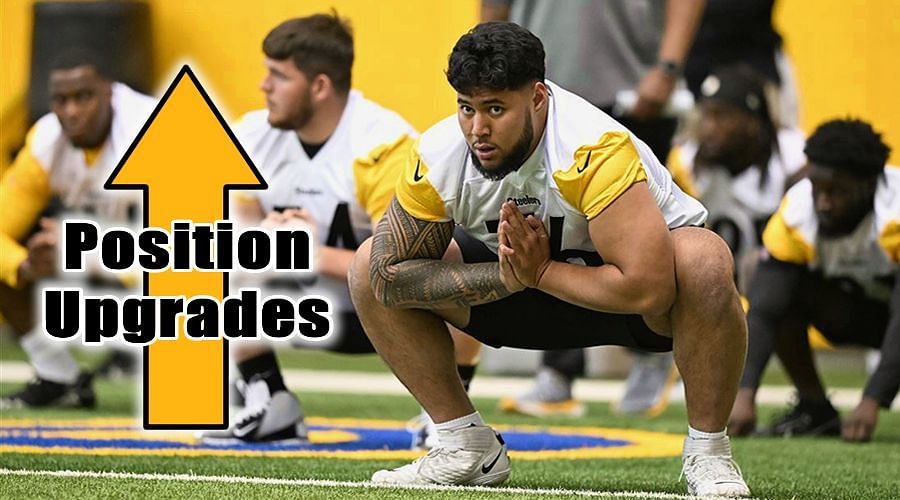
Most improved position groups across the 2024 NFL offseason
After spending the last month reflecting on what the player acquisition process looked like for all 32 teams, with a focus on the names brought in via the draft, it’s now time to take a step back and identify the positional units that improved the most throughout this process, comparing the additions and departures at those spots.
This is purely based on the players that were brought in/let go from the point the 2023 NFL season ended onwards, not taking injuries into account. So you’re not going to find the Jets here for getting Aaron Rodgers back from the torn Achilles he suffered four snaps into his time with New York for example. Along with that, I like to take a broader look at this in terms of which position groups were stocked up best rather than just talking about a singular star performer they acquired.
Let’s dive in:
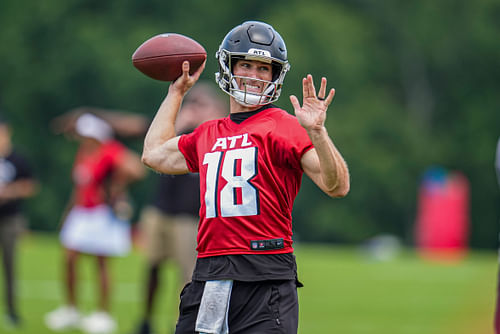
Quarterbacks – Atlanta Falcons
Additions: Kirk Cousins & Michael Penix Jr.
Departures: Desmond Ridder & Logan Woodside
While a lengthy conversation can be had about how Atlanta approached the way they constructed this QB room in general, I did discuss the implications that come along with it as part of my big draft recap and NFC South draft and roster review. However, I don’t believe anybody would argue that any of these position groups improved more from what they had this past season than the Falcons – even if the two honorable mentions below would be outlined by me in some other years – based on the combination of financial and draft capital investment they made here. I was pretty high on this offense coming into 2023, largely based on the pieces around the quarterback – including the play-caller in Arthur Smith. Yet, I also thought Desmond Ridder could at least be a serviceable distributor compared to the inconsistency of Marcus Mariota, based on my college evaluation of him and some of the positive flashes when he was inserted for the last month of his rookie season, also considering the confidence they showed by only targeting largely a backup signal-caller in Taylor Heinicke.
The accuracy and some of the decision-making Heinicke put on display didn’t live up to an NFL starter – even though worse circumstances than I anticipated made him look even worse, I’d argue. The 9-year pro is back on the latter half of his two-year contract, and he was at least good enough to earn a couple of starts over Ridder. His 24 starts in Washington were highlighted by his record-setting mark as the quarterback with the most completions in his first three NFL starts.
The other QB no longer on this roster compared to last season is Logan Woodside, who had 3x as many rush attempts (14) as attempted passes, as a designated kneel-down guy. So bringing in a four-time Pro Bowler on a 45-million-dollar average along with the eighth overall pick, who just led the FBS in passing yards and finished second in the Heisman voting, obviously is an astronomic shift.
Starting with the veteran and the guy pretty much cemented as the starter – outside of a setback in his recovery from the torn Achilles – based on the financial commitment they made, Cousins has consistently been on the fringe of being a top-ten quarterback over the last five years, only once ranking outside that range in terms of EPA per play across the league. This past season, his ranking at number six was actually the highest since 2016, while still in Washington, as he had the same offensive play-caller (Kevin O’Connell) in back-to-back years for the first time in his career as a starter. Zac Robinson will be calling the shots in Atlanta, working his way up as a former member of Pro Football Focus from assistant quarterbacks coach to pass game coordinator for the L.A. Rams. So we have a solid idea of what this offense could look like, considering Sean McVay began his NFL career in Washington with Kirk under center, while in L.A. they’ve drastically transitioned from the more traditional West Coast attack with a heavy dose of outside zone to running a lot more man-/gap-schemes and keeping the quarterback inside the pocket off play-action to take shots down the field, instead of booting that guy out. Considering where Cousins has had success in the past and the offensive line they’re putting in front of him to stay upright, this is a situation that should set him up for success.
Meanwhile, the rookie will have a certain adjustment period in terms of facing NFL defenses and engraining himself into this type of offensive system, but this is a 24-year-old who spent six years between Indiana and Washington. After dealing with a myriad of injuries at his initial stop, he’s stayed healthy these past two seasons with the Huskies and produced massive numbers – completing 65.4% of his passes for 9544 yards and 67 touchdowns compared to 19 interceptions, plus seven TDs on the ground. Personally, I thought he performed even beyond what those numbers would suggest and should have won the Heisman Trophy over LSU’s Jayden Daniels, as he battled through a scary slate of Pac-12 opponents – the top conference in college football – and led them to an undefeated National Championship appearance. In the playoff game against Texas, Penix showcased what he could be at his best, playing vertical throws to where his receivers can make plays for him, occasionally moving around before re-setting to fire from his hip and even without a clean platform being able to let it fly. The Falcons have the aerial weaponry to take advantage of that skill set with guys like Drake London and Kyle Pitts. For him, the difficulty will be to solve more complex defensive structures and not defer to laying throws up for his favorite target now, before he can Cousins’ level.
Either way, while I may question the ceiling of these more statuesque prototypes at the position – especially with their respective medical histories – I can easily envision these guys pushing the ball down the post or layering it to receivers working across the field. So these staple vertical play-action concepts are very much in their wheelhouse. With second-year star running back Bijan Robinson setting the table for it and the dimension he presents as a check-down option but also at times taking a linebacker deep, I think this crew could be highly effective.
Honorable mentions: New England Patriots & Pittsburgh Steelers
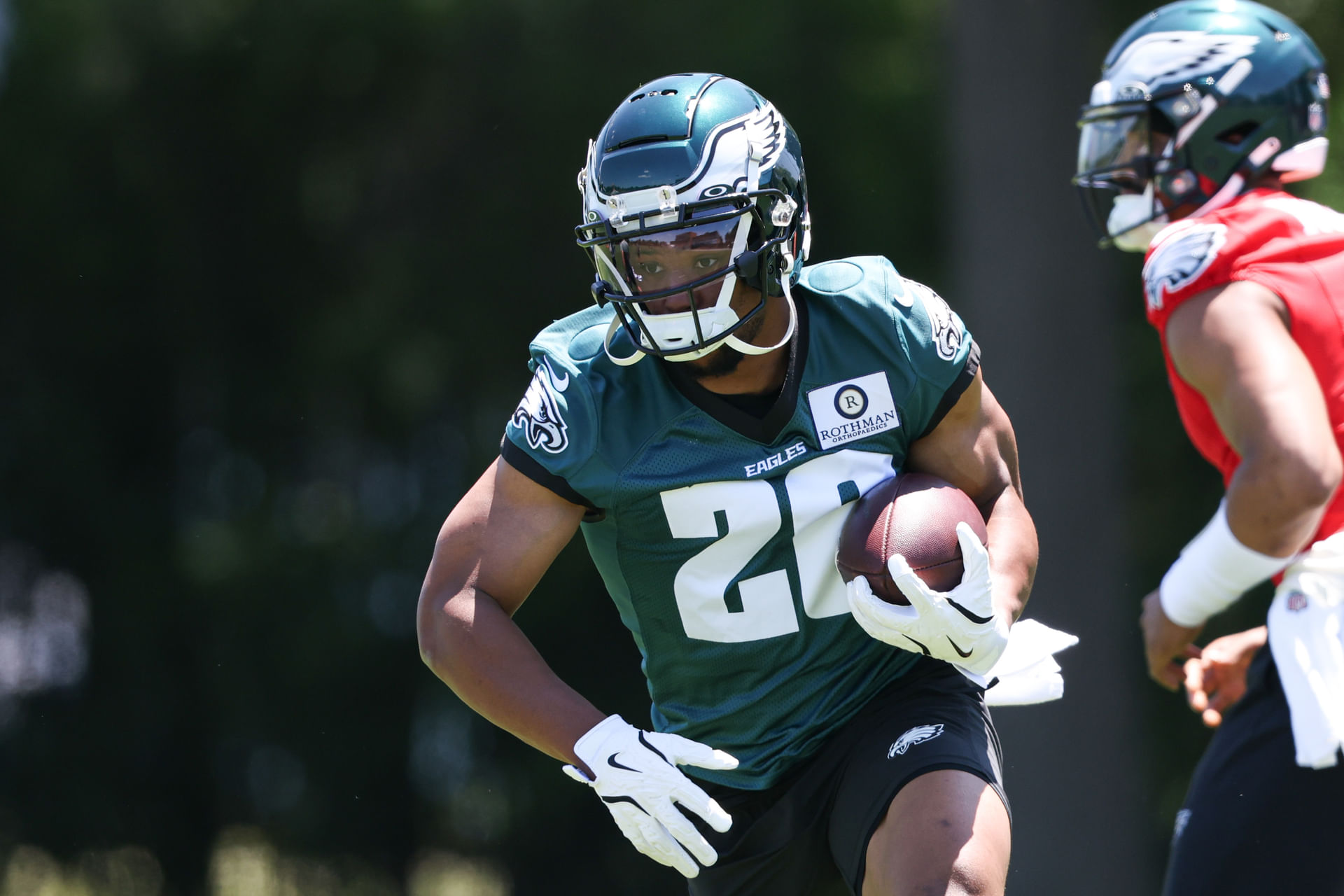
Running backs – Philadelphia Eagles
Additions: Saquon Barkley, Will Shipley & Tyrion Davis-Price
Departures: D’Andre Swift, Rashaad Penny & Boston Scott
It’s interesting to see the Eagles show up here, after I already listed them as an “honorable mention” in this category last year, considering the unwillingness of general manager Howie Roseman and the rest of that front office to invest in the running back position in the past. In fact, since then-head coach Chip Kelly surprisingly sent LeSean McCoy to Buffalo in a trade following the 2014 season, only one player had led the team in rushing for more than one of the nine years since then – Miles Sanders. And I would argue, while showing promise early on, he was always more of a product of the environment in Philadelphia, with an elite offensive line and run-game design for pretty much his entire run with “The Birds” before his production plummeted in Carolina last season.
Looking at the financial commitments at that position, over the last five years they’ve gone from 27th to 24th, 15th, 20th, and now 19th for 2024 in terms of RB cap spending – which will likely continue to go up with how Saquon Barkley’s contract is structured. Since they drafted Sanders in the second round back in 2019, the only RB they selected since then was Kenneth Gainwell as a fifth-rounder two years later, before spending a fourth-rounder on Will Shipley (Clemson) this April.
They did try to upgrade from Sanders to former Lions second-round pick D’Andre Swift, who they made a draft-day trade for a year ago, but ultimately he didn’t elevate a fairly predictable, simplistic run game and had the least productive receiving season of his career. They also signed Rashaad Penny on a one-year, prove-it deal, as someone who’s had some breakout performances but has consistently struggled to stay healthy as a former first-rounder for Seattle and he was barely even active for the Eagles this past year (12 touches). So signing Saquon to a three-year, 37.5-million-dollar deal as someone who’s basically averaged 100 scrimmage yards for his career as the driving engine for the division-rival Giants, and selecting a consensus top-10 RB in the draft, could provide a substantial upgrade.
Saquon led the league in scrimmage yards and was named Offensive Rookie of the Year back in 2018, only once did the Giants rank above 20th in terms of PFF run-blocking grade over the past five seasons (14th in 2022). That’s why his per-carry average over his time in New York was even higher than that 4.3 mark and in part why he’s not quite up there with the elite in terms of missed-tackle-forced rate, considering how of the he was met at or behind the line of scrimmage.
However, I felt compelled to make a video ascension back towards the top of the position in 2022, when his coaching staff created some favorable looks for the driving engine of that offense, and I thought in terms of setting up run plays conceptually and being a mature decision-maker, he was as good as ever. His ability to utilize different pacing, press either side of blockers to get second-level defenders leaning one way, hug pullers, and slice behind them are all excellent. So I don’t believe the Eagles brought him in to just stick in the shotgun and run inside zone as just over 50% of their designed rushing calls.
Jalen Hurts dealing with a knee injury for most of last season was not a part of that “gameplan” and of course, they want to set themselves up to major in the RPO game and their quarterback being able to pull the ball, which those trends facilitate, but we more diversity under former offensive coordinator and now-Colts head coach Shane Steichen. With Kellen Moore coming in to take over play-calling duties and O-line coach Jeff Stoutland being even more involved in their run game designs, I expect them to put more on their RBs in terms of all the different ways they’ll attack defensive fronts. Meanwhile, for anybody believing he might’ve lost a step in terms of open-field talent, Saquon was right there with two top-ten picks in Bijan Robinson and Jahmyr Gibbs in terms of Next Gen Stats’ average “rushing yards over expected” (0.39). And while Hurts often turns himself into the checkdown option, their new OC has consistently been one of the best at setting up screens to his backs.
Quickly on Will Shipley, I thought his biggest strengths as a runner at Clemson were that burst and how he uses his off-arm to win the corner initially on runs that hit outside, but even more so the ability to convert in short-yardage situations. He can take some of those carries that put a lot of physical strain on your body off the starter, while providing a component as a receiver that is pretty rare for a college RB, actually winning vs. linebackers on option and angle routes. I could see the rookie being on the field along with Barkley quite a bit as part of the “pony” personnel package, as they get the defense to match with base against their de facto 21 set, but then get all five eligibles out in the pattern to stress their opponents, along with a more diverse option run catalog potentially.
Honorable mention: Baltimore Ravens
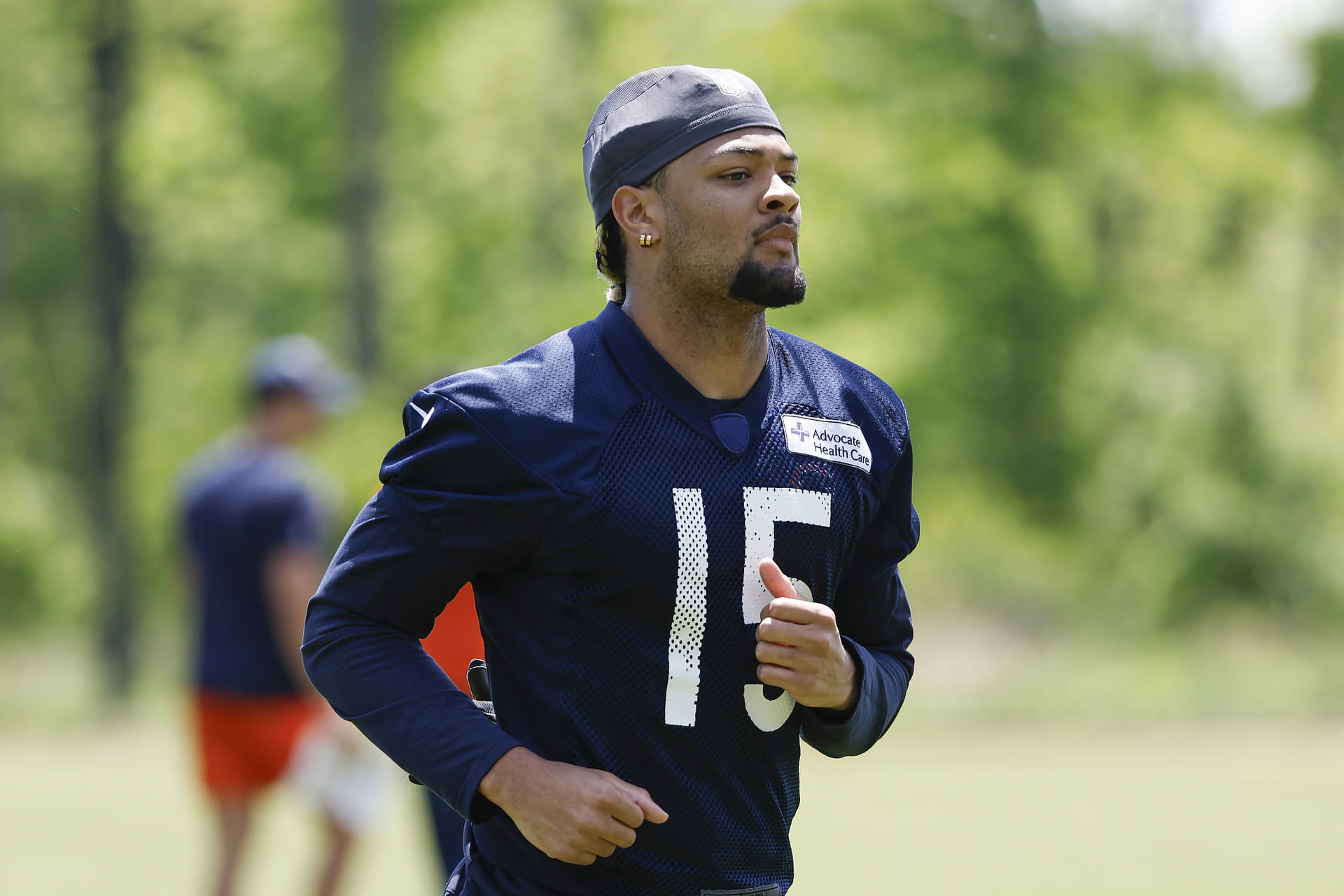
Receiving corp – Chicago Bears
Additions: Keenan Allen, Rome Odunze & Dante Pettis
Departures: Darnell Mooney, Equanimeous St. Brown & Trent Taylor
While it’s common for NFL teams to surround young quarterbacks with the appropriate weaponry, you don’t often see a team draft someone first overall – in the case of USC’s Caleb Williams, a generational talent I would argue – and put what could be the league’s premier trio of wide receivers around him. However, the Bears did not stand pat on having acquired a number one option in D.J. Moore last year, when they actually passed on the quarterback of their choice in that draft class and instead allowed the Panthers to move up for Bryce Young. Instead, they took the opportunity when Keenan Allen was made available via trade by the Chargers in transition mode to a completely new regime, to bring in the 32-year-old coming off a season in which he was on pace for leading the league in receptions (108 for 1243 yards and seven touchdowns in 13 games) before basically sitting out the final month for a team that was going nowhere.
Moreover, after using the number one pick they had coming in from Carolina to re-set the rookie QB clock and most likely upgrading from Justin Fields with Caleb, they still had their own selection (ninth overall) and didn’t hesitate to do what the majority of mock drafts predicted if available, as they completed the triplet with Washington’s Rome Odunze. I’ll get to why I believe their skill sets complement each other so well here in a minute, but let’s quickly acknowledge that Dante Pettis would’ve been brought back for a second year in Chicago this past season, before being placed on injured reserve and ultimately released, and now was re-signed this offseason. Meanwhile, Equanimeous St. Brown and Trent Taylor have largely been fringe roster candidates for their careers, while Darnell Mooney did have a 1000-yard season in 2022, but this current regime simply hasn’t prioritized involving offensive gameplans since then.
I believe before we discuss how this group of pass-catchers has come together, we first have to understand what it looked like previously. Two years ago, the group Chicago put out there alongside Justin Fields at that time was borderline criminal for any quarterback to have success with. That’s why D.J. Moore coming over from Carolina was a key piece in that trade that gave the Panthers the first overall pick in 2023. Yet, he ended up finishing sixth among NFL pass-catchers in terms of percentage of their team’s air yards, since he simultaneously was their top option vs. man, zone, and targets in the screen game and down the field – and he was effective in all those departments, but that’s not a sustainable strategy for a player to be the general “solution”. I still believe Darnell Mooney can be a useful receiver, in particular in the vertical game, but he’s more so a nice number three role player. Now, Chicago has actually assembled a cohesive pass-catching unit that new offensive coordinator Shane Waldron will be looking to maximize, with Cole Kmet being someone who will be slotted into an even more traditional in-line tight-end role.
Let’s start with the rookie here, because his presence dictates even more what the usage of the rest of the group should look like. Rome Odunze profiles as a legit X receiver, who you can isolate on the backside of the formation and ask him to win one-on-one, as you look at someone with a Reception Perception profile that indicates a success “in the green” across the full route tree. Along with being able to get open in a variety of ways, he also brings elite body control and just posted a 75% contested catch rate this past season, as the deferred option for Heisman runner-up Michael Penix Jr. because he’d routinely “make plays“ for his quarterback with the ball up in the air for him to snatch. Having that smooth operator, who can win through contact, allows Moore to play off the ball and enables motion at a much higher rate. At the same time, because that boundary safety when they’re in trips can’t consistently poach over to the number three and D.J. is lined up at Z more regularly, it expands that space to work for veteran Keenan Allen in the slot.
Sure, there will be teams that still try to run man against Chicago, especially looking at the histories of the defensive coordinators inside the NFC North, but not only can the former Charger manipulate leverage to keep DBs guessing to defeat them in isolated situations – even if those other guys might be targeted more regularly then – but the big-play ability of the fellow receivers and what a guy like Caleb Williams can provide on extended plays, we should see more shell coverage against this offense. And there may not be another pass-catcher outside of Chiefs tight end Travis Kelce who eats up static zone looks quite like Allen, with his ability to adjust routes on the fly, find soft spots, and be friendly to his (rookie) QB. His target share may go down a little bit compared to where it was previously, but when opponents ask Caleb to pick them apart with paper cuts or change the picture post-snap, this is the guy who can help him solve the puzzle.
Honorable mentions: Carolina Panthers & New England Patriots
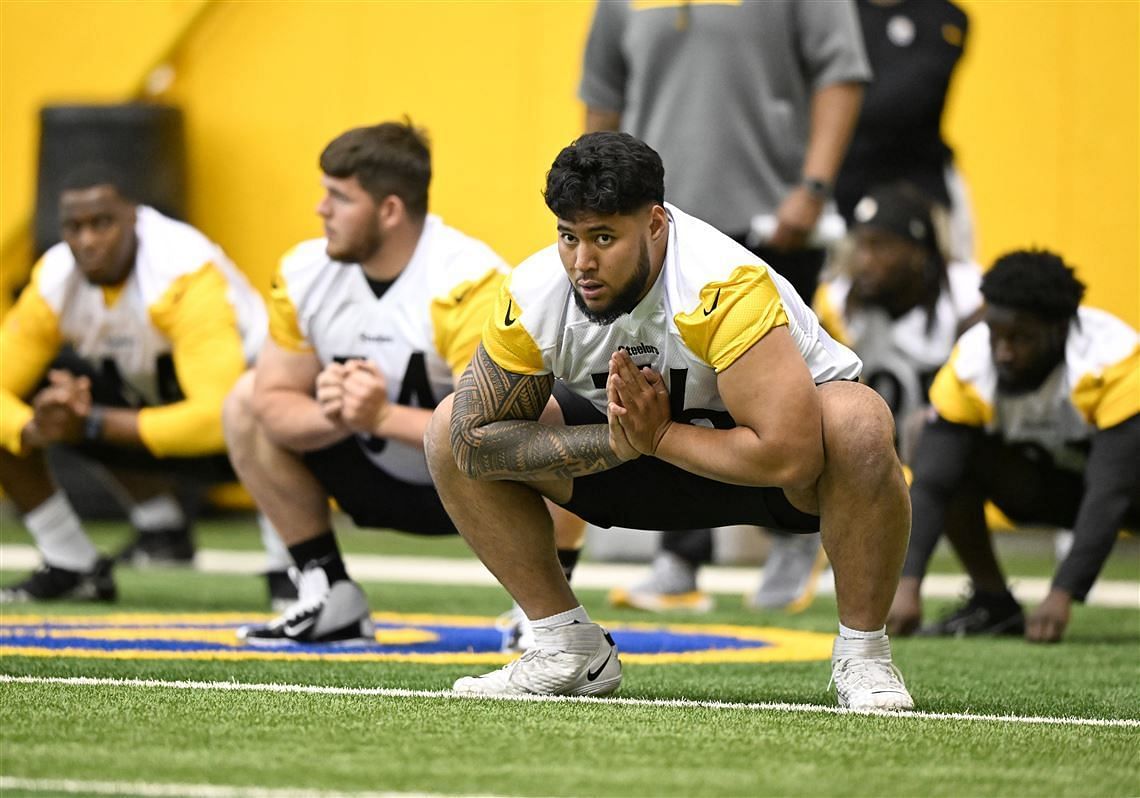
Offensive line – Pittsburgh Steelers
Additions: Troy Fautanu, Zach Frazier & Mason McCormick
Departures: Chukwuma Okorafor & Mason Cole
Something I’ve discussed on multiple occasions this offseason is the transformation we’ve seen this Steelers O-line undergo over 15 months, going from a bottom-three unit in 2022 to what could be the strength of the team for the future, with four new starters from where they started. The only two pieces remaining from days prior are James Daniels, who is expected to lock down the right guard gig for a third year in a row and can hopefully course-correct a little bit from a slight decline compared to his time in Chicago as an early second-round pick, and Dan Moore Jr., who Pittsburgh thankfully realized was a failed experiment as a guy they targeted early on day three a couple of years ago. Last offseason, they brought in former Eagle Isaac Seumalo on a very similar deal to Daniels, on a three-year basis between eight and nine million dollars annually, and while the Jets continue to deny this, I’ll always believe they got jumped by the Steelers for Georgia tackle Broderick Jones 14th overall in that draft.
Those were certainly positive steps, as their four highest-graded non-receivers on offense were those two with Daniels and Nate Herbig sandwiched in-between – and the latter of those is back for one more year, most likely now in a backup capacity. They did lose former starting right tackle Chuks Okorafor, who never graded above 63.6 for PFF in his six seasons and is prone to drawing flags at a high rate, and center Mason Cole, who only in one of his four seasons as a primary starter finished above 29th at his position in their database. Meanwhile, the Steelers just spent picks 20, 51, and 119 on three more additions to that front – the guys voted top lineman in the Pac-12 (Troy Fautanu), three-time All-Big 12 (Zach Frazier), and a back-to-back first-team FCS All-American (Mason McCormick).
Starting with Fautanu, there was a lot of discussion on where his optimal position would be since he does feature a fairly compact frame for a left tackle, but once he surprisingly measured in with 34.5-inch arms and reminded people of his impressive movement skills, people got more comfortable with the idea of him sticking on the edge. His short-area agility and the comfort he has at putting hands on smaller moving targets in space make him a great fit for an outside zone-based offense and what he can provide pulling or flying out to the corner in the screen game. More importantly, while his technique may not always be by the book, the way he can alter his approach based on the rusher he’s facing in dropback settings, the coordination and ability to recover in order to keep a blank slate, made him arguably the premier blindside protector in college football last season.
Progressing to Frazier, the reason he went later than his resume coming out of West Virginia may indicate, is that he broke his leg around Thanksgiving and while he participated in the field workout in Indianapolis already, he didn’t end up testing and was generally limited in what he could do during the pre-draft process. When you put it on the tape, his ability to reach-block a shade nose, overtake first-level defenders, adjust the way he comes in on combos, and secure linebackers on the move, was the most crucial piece of the Mountaineers' outside-zone rushing attack. As a pass-protector, he operates with good sink in his hips, tight elbows, and great patience, with a tremendous track record against the DL game-heavy Big 12. Finally, McCormick comes from an offensive system that relies more heavily on gap schemes and deployed the All-FCS guard heavily as a puller to blow defenders off their landmarks, yet his ability to cover ground out of his stance is surprising for a man with his rugged build. I did have some questions about how his style as a pass-protector would translate against a higher level of competition due to some stiffness, but he was actually dominant in that regard during East-West Shrine week and then finished eighth all-time among guards with a RAS of 9.96.
While McCormick will most likely be back up Pittsburgh’s two starting guards as a rookie at least, the guys expected to slot in at left tackle and center are actually perfect fits for what new offensive coordinator Arthur Smith wants to do in the run game, as the Falcons led the league in usage of outside zone in 2022 (58%) and were right up there near the top rate yet again last season. Along with that, if they want to use wide receiver Calvin Austin for more designed touches or even if Justin Fields doesn’t win the starting job, some of the package plays they may use him on, now you have a couple of guys who are very comfortable at angling up to the second level or walling off bodies on more extended runways, on top of clear improvements at those spots when you go to more traditional dropbacks. Of course, there are still rookies and there will always be somewhat of a transition period, but in terms of experience and “pro-readiness,” if you will, these three guys mentioned were right up there on the list of linemen in any draft.
Honorable mention: New York Jets
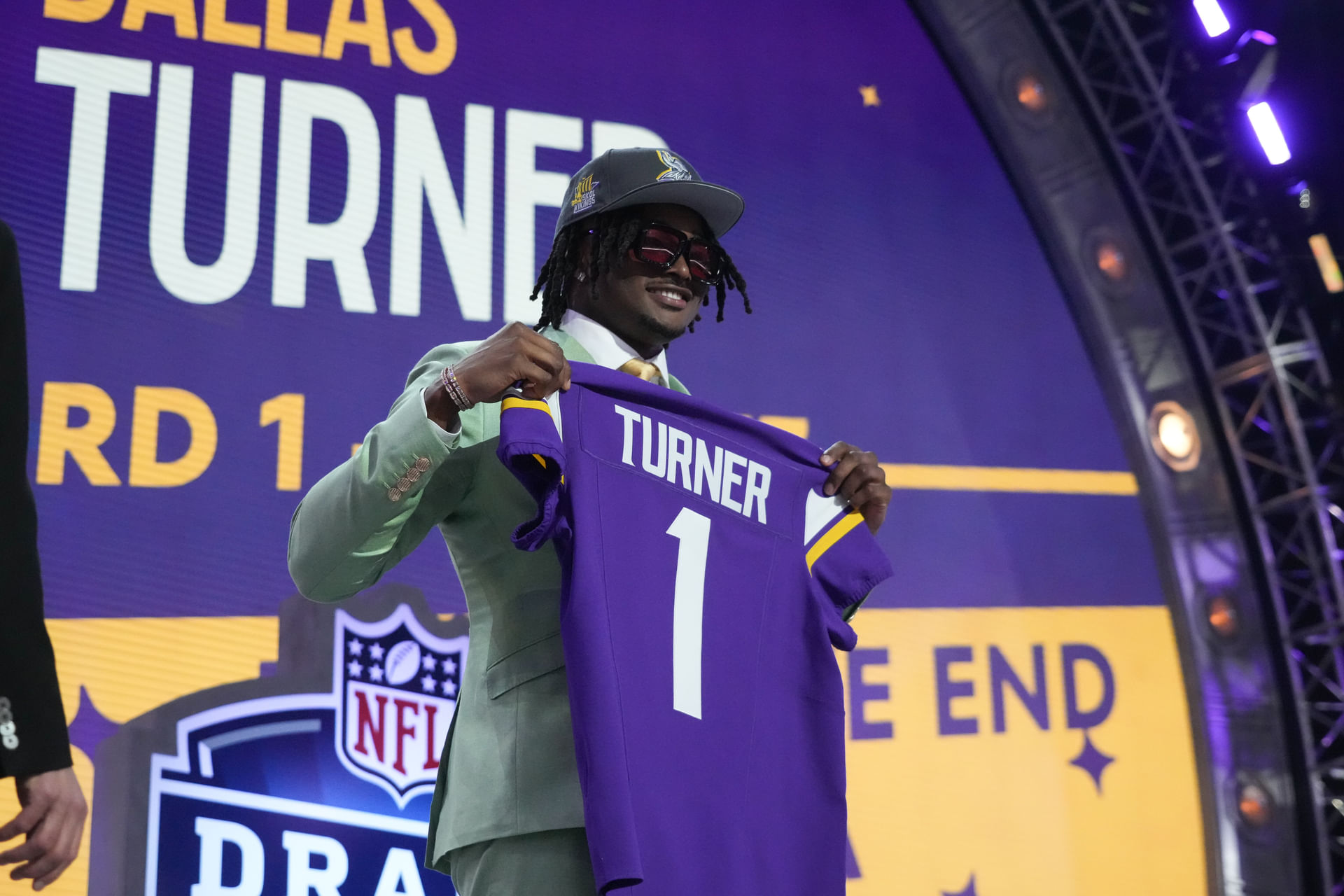
Defensive line – Minnesota Vikings
Additions: Jonathan Greenard, Andrew Van Ginkel, Dallas Turner, Jerry Tillery, Jihad Ward & Levi Drake Rodriguez
Departures: Danielle Hunter, Marcus Davenport, D.J. Wonnum, Dean Lowry & Khyiris Tonga
I’m going to cheat a little bit here since I included outside linebackers in this category for a 3-4 base front in Minnesota. Because while defensive coordinator Brian Flores drops those guys into coverage at a high rate, they’re still at their best going forward, and with how much we’ve transitioned to hybrid structures, they function as de-facto defensive ends in even fronts anyway. Therefore, the sheer amount of roster spots that have gotten overhauled is pretty massive for the Vikings. They swapped out long-time veteran Danielle Hunter for former Texan Jonathan Greenard, coming off a career year and arguably being a better bet long-term on a smaller financial commitment right now. Marcus Davenport was a productive pass-rusher for the Saints across his five-year rookie deal even though he may have never fully lived up to them investing two first-round picks on him, but he only played 118 snaps for Minnesota last season. The total numbers for D.J. Wonnum have generally looked pretty good, but they were always connected to extensive opportunities, while Dean Lowry and Khyiris Tonga have been replaceable rotational pieces on the interior for their NFL stints, as a 4-/5-technique and (shade) nose respectively.
On the edge, they brought in former Dolphin and worker bee Andrew Van Ginkel, who gained some experience playing off the ball last season, and they moved up with their second first-round pick to select arguably the highest-ceiling defender in the draft in Alabama’s Dallas Turner. That was paired with getting a couple of similarly built players who can line up anywhere from outside shade of the guard to tackle who have played heavy snaps in their careers in Jerry Tillery and Jihad Ward, along with taking a shot on a small-school guy in Levi Drake Rodriguez (Texas A&M Commerce) in round seven, as a sawed-off interior penetrator.
Quickly on Danielle Hunter leaving Minnesota eight/nine years into his pro career (missed all of 2020 following back surgery) – he’s been one of the most productive pass-rushers in the league pretty much since his second season, as one of the more unique/unorthodox players in that regard. He just posted career-highs in sacks (16.5), pressures (80), and tackles for loss (23) while playing over 1000 total snaps for the first time, but in terms of grading, he’s coming off his best season as a run-defender generally and definitely benefitted from the favorable looks created by defensive coordinator Brian Flores often bringing more rushers than the offense can block or at least create one-on-ones. So any production by the guys coming in, even as opponents find better answers for their all-or-nothing approach where they bring six(+) or drop eight guys into coverage, has to be viewed under that umbrella. With that being said, as we look at the next two years even – which make up the brunt of the contracts of Hunter and Jonathan Greenard (38 million dollars guaranteed) – you can make a solid case for the latter to be the more consistent player, with the gradual improvement he’s shown. He wins off the edge in more traditional ways, being able to time up his hand swipes to flip his hips at the quarterbacks as he gets to the top of the arc or converting speed-to-power from those wider alignments. Andrew Van Ginkel is an interesting one, because he played a career-high snaps off the ball (164), but also earned an elite PFF grade rushing the passer (90.6), with 53 pressures on just 321 opportunities. He started to emerge as a big-play creator, stripping the quarterback or scooping and scoring with loose balls.
However, that didn’t keep Minnesota from investing substantial draft capital into the position as well, when they sent a fifth-rounder along with a three and four each next year to move up six spots and select Alabama’s Dallas Turner 17th overall. At 6’3”, 245 pounds, he measured in with a 34-inch wingspan and put up some freakish testing at the combine, with his 40 and the jumps all being above the 90th percentile on the EDGE. That explosion combined with the ability to bend around the corner gives him massive potential, although currently, he’s also someone who primarily opted to go through tackles after stressing them with speed initially. I also thought he was an underrated edge-setter vs. the run, given how he plays with sink in his base and extension with his arms. We’ll have to see how exactly Minnesota intends on deploying both Jerry Tillery and Jihad Ward, who can be those oversized base D-ends on early downs but are best to use their length on the interior when it comes to passing situations. Tillery never lived up to his first-round pedigree with the Chargers, but just had his best season as a pro with the Raiders as an adequate-level starter.
Meanwhile, Ward has never been a particularly effective pass-rusher between the five stops he’s been at across eight years in the NFL, but has consistently seen the field, averaging 419 defensive snaps, thanks to being a sturdy presence with alignment versatility. How Flores divides playing time will be interesting, but I don’t think they lost anything in terms of their play between the tackles and then they got younger on the edges, with more bodies and upside to throw out there, as they’ll probably try to keep their guys firing off the corner fresh.
Honorable mention: Cincinnati Bengals & Arizona Cardinals
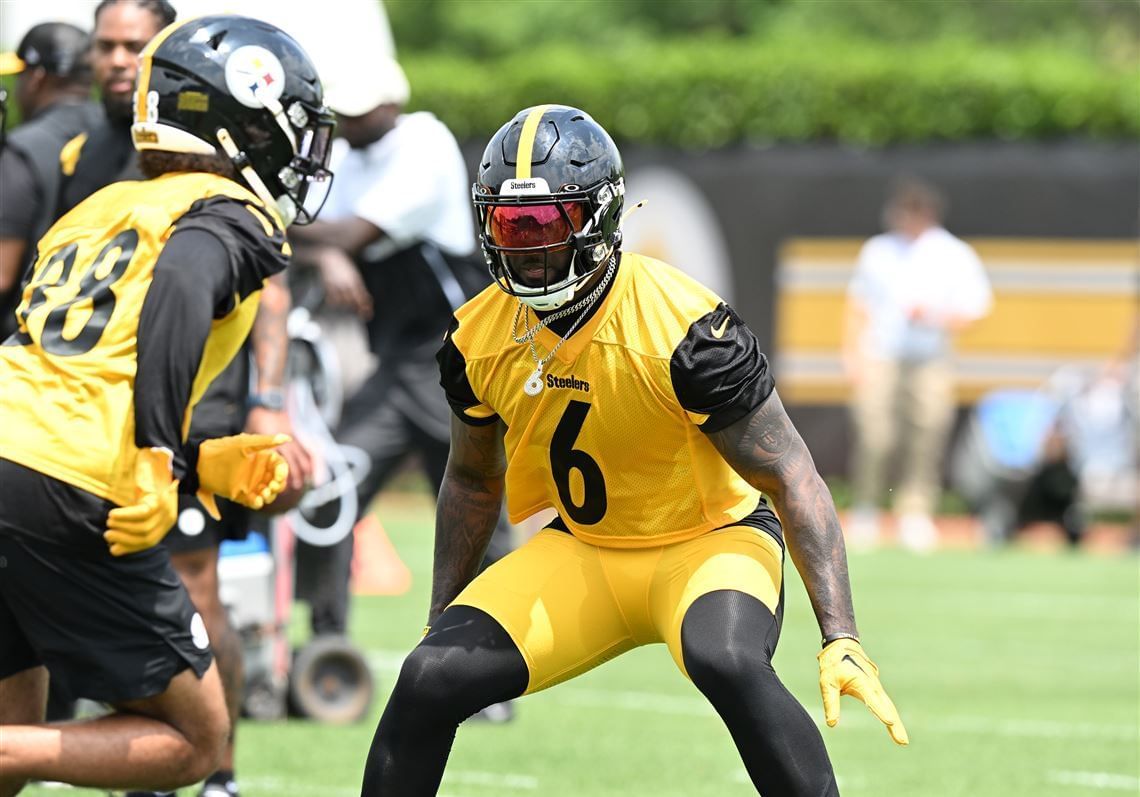
Linebackers – Pittsburgh Steelers
Additions: Patrick Queen & Payton Wilson
Departures: Kwon Alexander
The Steelers make the list for a second time here, as they signed one of only three off-ball linebackers to a contract of 10+ million dollars of average annual value, and selected one of six players at that position to go inside the top-100 of the draft. So it’s been a weak offseason for LBs generally and as we see trends across the league, where teams transition to more gap-scheme run plays and find ways to involve their receivers closer to the line of scrimmage, without necessarily having to use heavier personnel sets, I think we’ll see more emphasis on finding quality play – and better size – on the second level of defenses again. For now, as we look at Pittsburgh, the only legitimate departure they had there was Kwon Alexander, who outside of the two big-money years he had in San Francisco – where the Niners traded him to New Orleans less than midway through his four-year deal because they wanted to replace him with a young Dre Greenlaw – has barely earned over a million dollars on average across his other seven seasons and hasn’t been a quality starter since his rookie deal in Tampa Bay came to an end, while remaining unsigned at the time I’m writing this.
So instead, the Steelers handed out the biggest deal on a per-year basis (13.7 million) when they poached Patrick Queen from the division-rival Ravens. This was a bet on the steadily improving developmental curve since Roquan Smith was put next to him in Baltimore. Plus, when they got to the end of the third round in the draft this past April and the top linebacker for many, if you take out medical concerns, was available, they took an (educated) gamble on the reigning ACC Defensive Player of the Year in Payton Wilson.
Quickly on this linebacker situation in recent years – since 2020, which was the final season of Vince Williams as the last starting piece of the “Blitzburgh” ways, the average PFF grade of their off-ball LBs with 250+ snaps across the last four years is 53.1. Among 88 guys who qualified for those parameters this past season, that would’ve ranked 79th. And kind of the key piece here, even as we get to the actual additions here, is that they bring back both Elandon Roberts and Cole Holcomb, who logged the highest marks among all the Steelers qualifiers with what they contributed in 2023. Regardless, none of them present the type of complete skill set Patrick Queen does, who has shown steady improvement throughout his four years in Baltimore and just made his first Pro Bowl. Along with contributing 9+ tackles for loss each season collecting a pressure on basically every fourth snap he was used to rush the passer over the last two (48 pressures on 215 such snaps), he also just had his best campaign in coverage – the area where he was taken advantage of mostly early in his career – holding opponents to 6.5 yards per target his way. What really unlocked this player was when Baltimore traded for Roquan Smith at the 2022 deadline, who would clean up some of the chaos Queen created, as he was allowed to play forward a lot more and didn’t need to decipher as much information. Yet, you did see him develop a better feel for spacing to not get taken advantage of when put in conflict as a coverage defender and sorted through the action in the backfield more cleanly.
The other name they brought in at the second level of their defense was the top-ranked linebacker for me and many others if you take out injury complications. Payton Wilson has had double-digit surgeries since his senior year of high school and when he ultimately came off the board at the end of day two, the sentiment was that he might ultimately be a one-contract player. With that being said, he always plays the mentality that any snap could be his last and if that means there’s a slightly higher chance of re-injury, for this season specifically, there’s no denying that he brings a dimension that none of the veterans outside of Queen provides. When you put on the tape, this guy’s range and effort jump out straight away. You constantly see him chase down the ball way outside his area and if you go to the broadcast angle, there’s this maniac coming out of nowhere to bang guys down. He does have more of a slender frame, where he can have a tough time deconstructing blocks with someone in his face, but that short-area burst to beat guys to a spot and his ability to cover ground laterally track plays from the backside made him a highly effective run-defender. His length extends the ground he can cover and he looks comfortable having to carry guys vertically in match assignments. Plus, he may be at his best rushing the passer, where he can reduce the shoulder as he comes straight off the edge or beat guys across their faces with his suddenness when blitzing from depth. Considering he missed less than 5% of his attempted tackles last season, he should be a great compliment to Queen still failing to bring guys down as reliably due to the aggressiveness he plays with.
Honorable mention: Washington Commanders
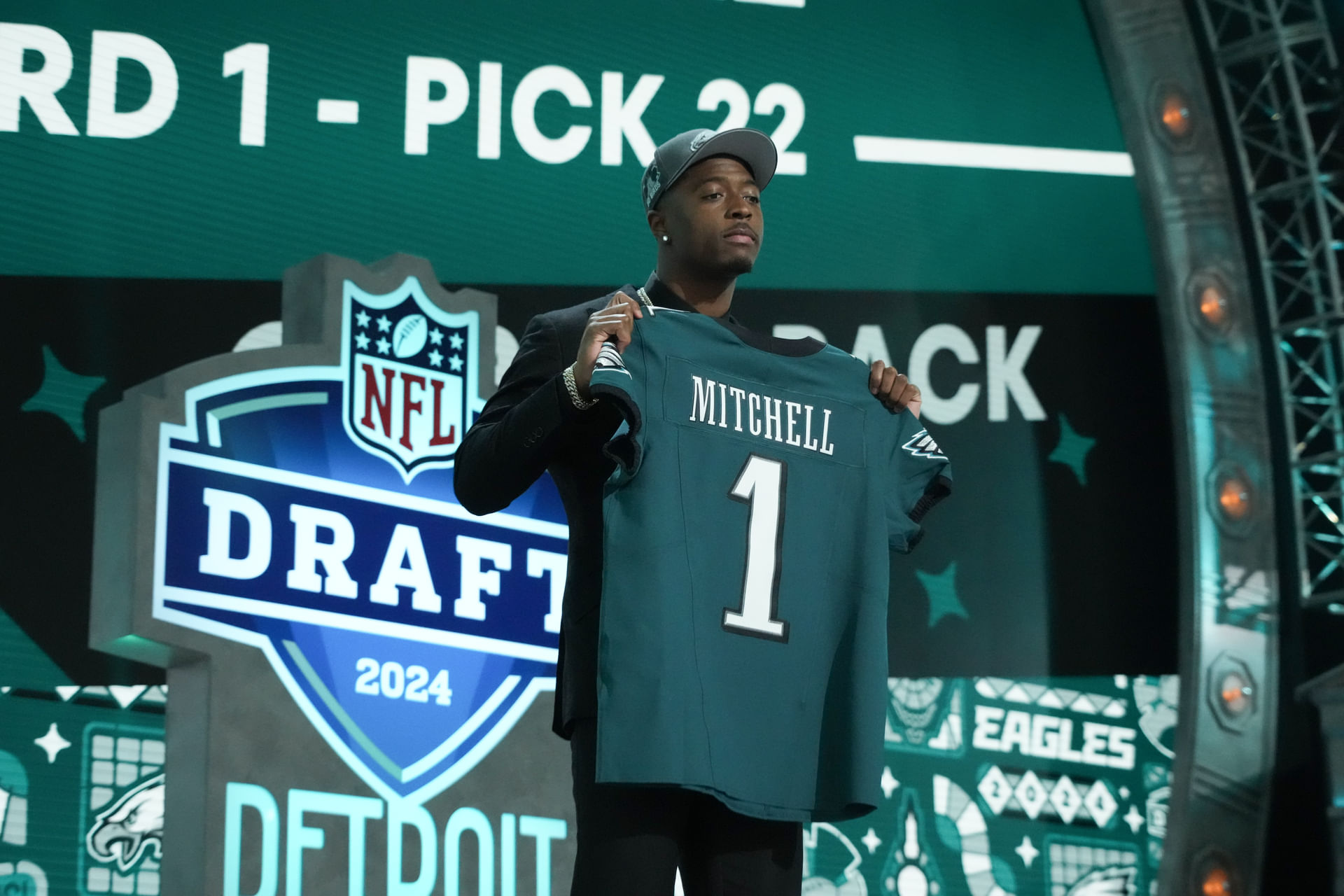
Secondary – Philadelphia Eagles
Additions: C.J. Gardner-Johnson, Quinyon Mitchell, Cooper DeJean & Andre’ Sam
Departures: Justin Evans & Terrell Edmunds
Finally, the Eagles are a team that actually spent up pretty well to retain the pieces they had in places in the secondary, paying market-value deals to both their starting corners coming off Pro Bowl seasons, with Darius Slay and James Bradberry entering the year 33 and -30 seasons respectively both on three-year deals for a combined 80 million dollars, without much wiggle room. Those guys are still there – along with nickelback Avonte Maddox on a one-year, 1.6-million-dollar contract – but it didn’t stop them from using picks 22 and 40 on what were considered top-five DBs in this draft with Quinyon Mitchell (Toledo) and Cooper DeJean (Iowa), who are both multiple-time all-conference performers with plenty of ball-production. After a one-year stint in Detroit that was marked by injury, safety C.J. Gardner-Johnson is back on another one-year deal. Plus, they signed undrafted free agent Andre’ Sam, who’ll be battling for a roster spot to contribute on special teams primarily.
In terms of the losses they are dealing with, veteran safeties Justin Evans and Terrell Edmunds have both since signed with their fourth pro team in years five and seven respectively, who they didn’t get 200 defensive snaps from either, due to injury and trading the latter to Tennessee at the deadline respectively. So really, their entire corner room remains intact, with a couple of young guys they threw out there at times last season hoping to take a step, while at safety they effectively replaced one functional starter between those two names just discussed with the guy that led them with six interceptions and was a key presence in their run to a Super Bowl appearance a couple of years ago. We’ll get to how I believe they might construct that secondary ultimately, but on paper at least they got younger and have given themselves more options before we even discuss the quality of play.
As for Slay, his total yards, yards per target and PFF grade have gotten worse each of the past two seasons. For Bradberry, it was more of a steep cliff, as he surrendered 260 yards and seven touchdowns more on eight additional targets compared to his second-team All-Pro campaign the year prior, as someone opposing teams actively targeted. That’s why despite the financial commitments they made at corner, Philadelphia spent two top-40 picks (trading up for the latter) on Quinyon Mitchell and Cooper DeJean.
The former became a rare back-to-back second-team All-American for Toledo, thanks to leading the FBS with 50(!) total passes defensed over the past two seasons combined (including six interceptions). However, he ascended to CB1 status by locking down pretty much everybody during Senior Bowl practices – to negate some concerns around what he might look like against a higher level of competition – and then nailing the combine as well. Quinyon exclusively lined up at the field-side corner for the Rockets, where he barely played lined up in press, but rather showcased his tremendous spatial awareness, anticipation skills, and ability to key on route patterns that set him up for such massive ball production. Similarly, DeJean was tasked with a high rate of off-zone assignments, although he’s more solidly built to play in the slot and closer to the box, which at least in 2022 he did quite a bit already. He doesn’t have the same kind of quick-twitch athleticism to excel in isolated situations, but his mental fortitude to decipher route patterns and make plays off his landmarks is even more advanced than one of his new teammates, and he could be an elite run defender playing inside or out.
What will happen at safety is much easier to figure out, since C.J. Gardner-Johnson had a full season with the Eagles before taking a one-year absence with the Lions. Now, he was working under Jonathan Gannon at that time, who relied more heavily on static cover three and four, while now under veteran defensive coordinator Vic Fangio, they will not only split the field more extensively in the way they structure the back-end, but they’ll also change the picture on opposing quarterbacks more regularly at the snap.
Philly traded peanuts for Gardner-Johnson on the eve of 2022, yet after almost exclusively playing the nickel for the Saints before that, he was used much more as a traditional safety. However, not only did that lead to substantial ball production thanks to his instincts (tied for a league-leading six interceptions), but as the year progressed you saw him grasp how to angle down from depth to create stops in the open field, including a couple of awesome solo tackles for limited yardage on what looked like it could end up being explosive runs in the Super Bowl at the end of the year. So while I believe they’ll base out of two-high looks quite a bit still, this is someone you can trust in the high post and particularly on third downs, Fangio may want to run his different variations of cover-one, where they put either Reed Blankenship or Sydney Brown as a rat or hole player. The latter could also be used quite a bit as a big nickel or dime backer, Quinyon Mitchell and Darius Slay will likely be your two starters outside, and Cooper DeJean battles Avonte Maddox for the slot gig against more traditional sets. Either way, this secondary got a lot younger and more versatile in the ways in terms of personnel and coverage variety.
Honorable mentions: Detroit Lions & Miami Dolphins